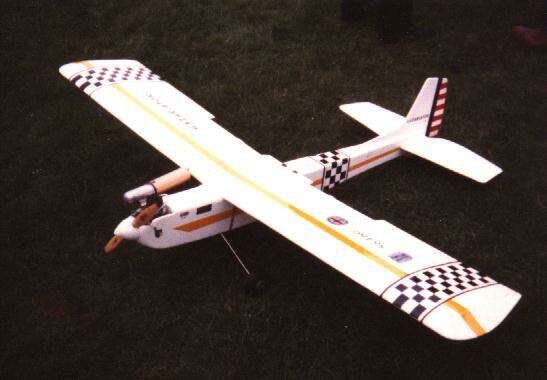Ivy and Martin's Web Page
|
The Gazariator is a non-scale model of functional design. The structure is a combination of sheet and built-up balsa with
fabric covering. It requires either a .60 2-stroke or .90 4-stroke engine and 4-channel radio. The wingspan is 78 inches and the weight should be between 6 and 9 lb.
The plans as supplied show the entire model structure in detail, with sufficient instructions. The quality of materials supplied is good, with accurate cutting of the ply components.

Structure The fuselage sides are cut from balsa sheet. The sides are joined by plywood formers at the front and balsa ones further back. Curiously, the top decking behind the wing is a thick (and heavy) balsa block which would benefit from substantial hollowing out to reduce the amount of ballast needed in the nose. The engine is mounted upright on a radial mount bolted to the front 1/4 inch ply bulkhead, with a balsa block cowling built up around it. The undercarriage is intended to be tricycle, with a sprung noseleg attached to the engine bulkhead and the piano wire main gear aft of the centre of gravity, attached to the underside of the fuselage with saddle clamps. I chose to build it as a taildragger instead, dispensing with the noseleg and moving the main u/c forward to a point just behind the wing leading edge. A plywood tailskid was fitted at the rear.
The wings are made in two halves, which are then permanently joined. Assembly is straightforward with balsa spars, and strip leading and trailing edges. Balsa sheet strip ailerons are fitted the full length of each panel.
The front third of the wing is covered in balsa sheet on the both surfaces, the rest being fabric covered. The dihedral brace is a little unusual as it is a separate piece of spar which slots horizontally between the two panels through holes in the wing ribs, rather than binding the spars together as normal.
The tailplane and fin are built as 1/8 inch thick flat frames which are then fully sheeted with balsa. The elevators and rudder are sheet balsa. The whole tail assembly is permanently attached to the fuselage. Doped nylon covering is used on the wings. More modern heat-shrink covering materials may be used instead. The rest of the model is treated with sanding sealer and tissue covered. There is plenty of space for the radio installation in the space beneath the wing. The rudder and elevator are driven by stiff balsa pushrods or plastic snake rods. The aileron servo is mounted in the centre of the wing. Flying the model This is basically an advanced trainer type model so it is positively stable and forgiving. With a powerful engine it is surprisingly fast and capable of most manoeuvres. The wing has plenty of area, giving it a good lifting capacity. I have used mine to carry small cameras with ease. Take-off requires very little rudder correction, and I would imagine the tricycle version is even easier. Landings are easy, especially with the non-standard wing flaps, which I recommend. With flaps the model has a tremendous speed range and a steep approach angle. Structural Assessment The structure is for the most part standard for this type of model. I only have two reservations: Firstly the thick balsa block providing the fuselage rear decking is completely unnecessary. It adds a lot of weight behind the centre of gravity and contributes no useful strength as the balsa box structure is more than sufficiently strong without it. Secondly I prefer dihedral braces to link the spars in each wing panel together in such a way as to transfer the loads as efficiently as possible. Using a separate piece of spar material inserted through the ribs and not bonded directly to the spars is not a good way of transferring loads across the centre section, as it relies on distributing the load from spar to rib to brace. Final verdict This is an easy model to build although lacking in good looks. It is a very good flyer and ideal for those who want to experiment with structural modifications or carrying things like cameras etc. Anybody know where the name "Gazariator" came from? |
Have your say! Do you have any comments, observations, experience you would like to add? Do you agree with the above, or disagree?
All valid contributions will be added to the review, credited to you. Simply fill in the form below and click the "send form" button.
None of your personal information will be passed to anybody else for any purpose whatsoever.
| Back to Kit Review Index | Main Index | Martin's Photography on Picfair | Our stuff on Redbubble | Email Martin |